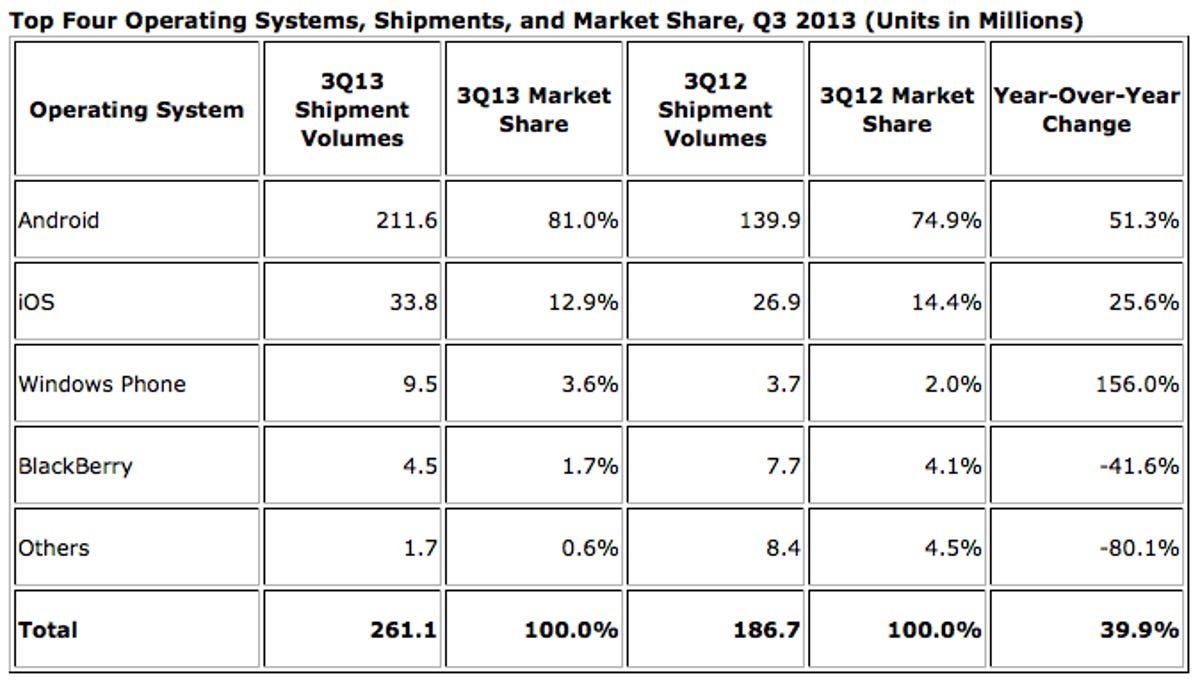For the first time ever, Android has hit more than 80 percent market share for smartphone shipments worldwide.
The new Worldwide Quarterly Mobile Phone Tracker was released on Tuesday by IDC, which detailed third-quarter numbers for all smartphone shipments worldwide. A total of 261.1 million smartphones were shipped during this quarter, 81 percent of which run Google’s operating system. A study by Strategy Analytics last month revealed nearly the same numbers, showing that Android gobbled 81.3 percent of the global smartphone market in the third quarter.
There are several smartphone manufacturers that run Android on their devices. Of these vendors, Samsung gained the most market share. The Galaxy S4-maker ruled 39 percent of all Android smartphone shipments in the third quarter. The majority of the other vendors saw market share within the single digits or less.
Not only must Google be giving itself a pat on the back, but Microsoft should also be pleased by the third-quarter numbers. During the quarter, Windows Phone shipments jumped 156 percent year-over-year. While Windows Phone market share is still small — less than 5 percent — these numbers do show that people are purchasing the smartphones at a rapid rate. Kantar Worldpanel ComTech reported similar numbers in September showing that Windows Phone is increasingly gaining in the world market.
For Windows Phones, Nokia appears to be the smartphone maker of choice. A whopping 93.2 percent of all Windows Phones shipped in the third quarter were made by Nokia.
“Android and Windows Phone continued to make significant strides in the third quarter. Despite their differences in market share, they both have one important factor behind their success: price,” IDC’s Mobile Phone team research manager Ramon Llamas said in a statement. “Both platforms have a selection of devices available at prices low enough to be affordable to the mass market, and it is the mass market that is driving the entire market forward.”
Related stories
- Please, Clear Your Android Phone’s Cookies and Cache Right Now
- Best Samsung Phone for 2022
- Best Android Tablet for 2022
- Best Mobile VPN of 2022
- Android 12 Has Some Tricks Up Its Sleeve, But You Have to Know Where to Look
Overall smartphone shipments were up 39.9 percent year-over-year in the third quarter. According to IDC, average smartphone selling prices have decreased as of late as demand for cheaper phones grows. The average price is now at $317, which is 12.5 percent lower than last year.
One exception to the lower price is for large-screened smartphones, or phablets. The average phablet price is currently hovering around $443; however, this is still 22.8 percent lower than last year’s average phablet price of $573.
“Almost all successful Android vendors have added one or more 5- to 7-inch phablets to their product portfolios,” IDC’s Worldwide Quarterly Mobile Phone Tracker program director Ryan Reith said. “And Nokia’s recent announcement of the Lumia 1320 and 1520 put them in the category as well. In 3Q13, phablet shipments accounted for 21 percent of the smartphone market, up from just 3 percent a year ago. We believe the absence of a large-screen device may have contributed to Apple’s inability to grow share in the third quarter.”
And, this brings us to Apple. While iOS does well in the US, it’s not as popular in the world market. In the third quarter, Apple held 12.9 percent of the market share, which is a 1.5 percent decline from last year. However, the company’s shipments were up from 26.9 million during last year’s third quarter to 33.8 million in this year’s third quarter. According to IDC, some of this market share decline could be due to soft demand in the weeks before the launch of the iPhone 5S, iPhone 5C, and iOS 7 in September.


IDC



